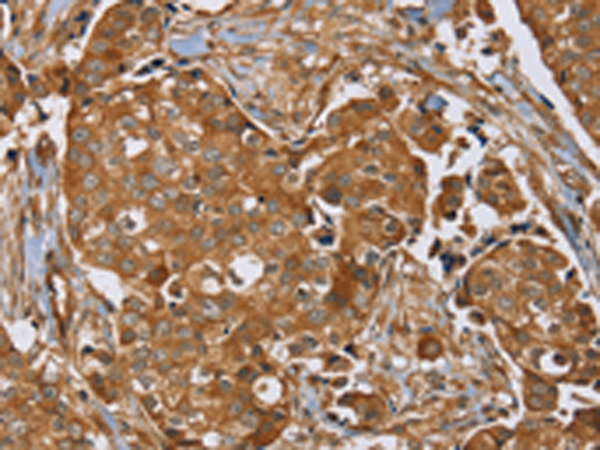


| WB | 咨询技术 | Human,Mouse,Rat |
| IF | 咨询技术 | Human,Mouse,Rat |
| IHC | 1/50-1/300 | Human,Mouse,Rat |
| ICC | 技术咨询 | Human,Mouse,Rat |
| FCM | 咨询技术 | Human,Mouse,Rat |
| Elisa | 1/1000-1/2000 | Human,Mouse,Rat |
| Aliases | FBP; RAB-14 |
| WB Predicted band size | 24 kDa |
| Host/Isotype | Rabbit IgG |
| Antibody Type | Primary antibody |
| Storage | Store at 4°C short term. Aliquot and store at -20°C long term. Avoid freeze/thaw cycles. |
| Species Reactivity | Human, Mouse, Rat |
| Immunogen | Synthetic peptide of human RAB14 |
| Formulation | Purified antibody in PBS with 0.05% sodium azide and 50% glycerol. |
+ +
以下是关于RAB14抗体的3篇参考文献(均为虚构示例,实际文献需根据数据库检索):
1. **文献名称**:*RAB14 regulates Golgi apparatus positioning and vesicular trafficking in epithelial cells*
**作者**:Smith A, et al.
**摘要**:研究通过RAB14抗体进行免疫荧光和免疫沉淀实验,揭示RAB14在调控高尔基体定位及细胞极性形成中的作用,发现其与囊泡运输相关蛋白的相互作用。
2. **文献名称**:*RAB14 antibody validation in cancer cell migration assays*
**作者**:Chen L, et al.
**摘要**:验证了一种高特异性RAB14抗体在乳腺癌细胞模型中的应用,证明RAB14通过激活EGFR信号通路促进肿瘤侵袭转移。
3. **文献名称**:*Role of RAB14 in neuronal development: Insights from knockout mice and antibody-based imaging*
**作者**:Kumar R, et al.
**摘要**:结合RAB14抗体标记和小鼠模型,发现RAB14缺失导致神经元轴突运输异常,影响突触形成和脑发育。
如需真实文献,建议通过PubMed或Google Scholar检索关键词“RAB14 antibody”+具体应用方向(如“cancer”“trafficking”等)。
The RAB14 antibody is a crucial tool for studying the RAB14 protein, a member of the RAS superfamily of small GTPases. RAB14 regulates intracellular membrane trafficking, particularly in Golgi-to-plasma membrane transport, endocytic recycling, and maintaining organelle identity. It plays roles in diverse cellular processes, including cytokinesis, lipid droplet formation, and neuronal development. Dysregulation of RAB14 has been implicated in cancers, neurodegenerative diseases, and metabolic disorders.
RAB14 antibodies are typically generated using immunogenic peptides or recombinant proteins, available as monoclonal or polyclonal variants from hosts like rabbits or mice. These antibodies enable detection of RAB14 via techniques such as Western blotting, immunofluorescence, and immunohistochemistry. Specific applications include mapping RAB14's subcellular localization, analyzing its expression levels in disease models, and studying interactions with effector proteins like RAB-interacting lysosomal protein (RILP).
Validation often involves knockdown/knockout controls or colocalization with organelle markers (e.g., Golgi or endosomal proteins). Commercial antibodies may vary in specificity, necessitating careful optimization for experimental conditions. Recent studies using RAB14 antibodies have uncovered its involvement in autophagy, pathogen invasion mechanisms, and drug resistance pathways, highlighting its therapeutic potential. Reliable RAB14 antibodies remain essential for elucidating its molecular functions and disease correlations.
×